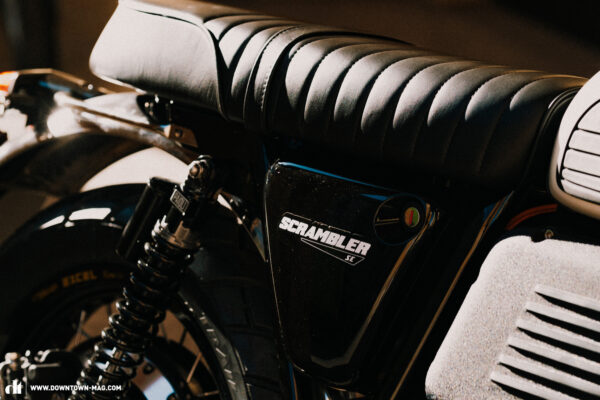Love at first sight? With its sexy café racer look, the RGNT No.1 could have popped straight out of the 1960s. But this electric motorcycle is about more than just looks – it offers a whole new riding experience. We put the RGNT No.1 through its paces and uncovered the benefits and potential drawbacks of electric motorcycles.

The model name, No.1, reflects its pioneering spirit. While the market already boasts numerous electric motorcycles, the RGNT No.1 stands out for its striking looks. First introduced onto the market in early 2020, the No.1 has quickly become an electric vehicle icon, seamlessly blending in with the legendary café racers of the 1960s. But the Swedish start-up’s ambitions go way beyond just looks. RGNT want to usher in a noiseless era on the roads, revolutionise the motorcycle industry, and become the market leader in their segment – undoubtedly lofty goals! Currently, the newcomer has two different models in their portfolio: the RGNT No.1 Classic and the RGNT No.1 Scrambler. As the names suggest, the Classic model has a vintage appeal and is designed for on-road riding, while the Scrambler version has a sportier attitude and is designed for light terrain such as gravel roads. We had the opportunity to extensively ride the RGNT No.1 Scrambler in the Sport Extended edition, which comes at a starting price of € 15,495.


Is silent speeding the future? – The pros and cons of electric motorcycles
Picture this: It’s a quiet Sunday morning, the weather is beautiful and you’re ready to hit the road. As you straddle your motorcycle, instead of a traditional 15-litre fuel tank, you’re sitting on top of a 9.5 Wh battery. Your neighbour greets you with a friendly wave, a stark contrast to the frustrated gestures often associated with loudly burbling engines. Thanks to the bike’s silent electric motor, you can enjoy the ride without disturbing anyone or attracting disapproving looks – just twist the throttle and immerse yourself in the great outdoors. Navigating city traffic takes on a whole new dimension with an electric motorcycle. With no clutch lever and no gearbox, you can relax and just concentrate on the road ahead. Even in the sluggish crawl of rush hour traffic, you’re no longer sitting above a scorching 90°C engine block. The only thing making you break a sweat is the age-old question of which lane is going to be faster.

Of course, all that glitters is not gold, and for all its advantages, the electric motor doesn’t come without its drawbacks. In the scorching summer heat, the electric motorcycle can indeed face a challenge: Temperatures above 30 degrees Celsius trigger the software to reduce the engine’s power output, a precautionary measure against possible overheating due to prolonged or intensive use of the electronics. Also, historically, riding a motorcycle has always involved certain risks. The combination of often high speeds and a smaller profile than a car increases the likelihood of being not seen. The newfound silence of the electric motor adds to the problem, as you are not only less visible but also less audible. Even road cyclists remain oblivious of your presence until you glide alongside them, making them jump. In urban environments, an optional sound module could come in handy to alert pedestrians and cyclists.
The electric motor on motorcycles divides opinion: While many people think the e-motorcycle is cool, for others it is sacrilege. But there is no denying that the electric motorcycle opens up new possibilities and perspectives.
Back to the future – The design of the RGNT No.1 Scrambler SE electric motorcycle
The RGNT No.1 takes us back to the legendary 1950s and 1960s, when huge road cruisers with chrome grilles and café racers ruled the streets and rock ’n’ roll blared from the speakers in bars. With the No.1, the RGNT design team has successfully brought the retro look of a café racer into the modern age. Curved lines and vintage touches set the tone. Beautiful spoked wheels, gleaming chrome mudguards, flat leather seat – check! But what about the tank and the engine? A closer look reveals that the black box under the fuel tank does not contain a V8 engine, but the 9.5 kWh batteries and what appears to be the fuel tank, actually houses the control and charging electronics.



Beneath the leather seat is a small, lockable storage compartment, just big enough for a small snack or the essential driver’s licence and charging card. You can customise your bike using the configurator, which lets you personalise the seat, mudguards and tank colour. Of course, all these individual options come at an extra cost – our test bike is priced at € 17,221. Meanwhile, the basic version of the No.1 Scrambler SE starts at € 15,495 and comes in a sleek all-black finish. When it comes to pricing, the difference between conventional combustion engines and electric motorcycles is marginal – after all, paving the way for innovation comes with a price tag of its own.


Range and charging speed of the RGNT No.1 electric motorcycle
In the past, refuelling conventional combustion engines was an afterthought. But with electric motorcycles, recharging is a crucial consideration. The actual range on a single charge is around 150 km, depending on topography, riding style and the rider’s weight. This means that the RGNT No.1 will not be able to make the great Alpine tour without a stopover. It is far more suited to one-day trips to explore the region. For a commute followed by a joyride, the range is more than adequate.
The battery capacity is 9.5 kWh. This is about 13 times the capacity of an ebike battery. In 3 hours you can fully recharge the electric motorcycle via a Type 2 plug. The catch is that most 11 kW and 22 kW charging points do not have a fixed cable, meaning you have to bring your own. Unfortunately, the RGNT No.1 doesn’t have a storage compartment for it, so you’ll have to stash it in your backpack or sling it over your shoulder like a lasso. Alternatively, you can charge the No.1 at home or on the move using a standard household socket. You’ll need convenient access to a socket or a long cable, though, as the 60 kg battery is permanently integrated and can’t be removed. This method takes about 6.5 hours to fully charge. But if you only charge from 20% to 80%, it’ll take about 3.5 hours before you’re ready to hit the road again.


Only the most dedicated riders who brave the freezing cold on an icy winter’s day may face issues with decreased range, similar to what happens with electric cars. If the motorcycle is left stationary during long stretches in winter, it’s a good idea to fully charge the battery at least once every 25 days. This helps safeguard the battery and prevents potential harm caused by a deep discharge.
Hit the road – The RGNT No.1 Scrambler electric motorcycle in the test
The RGNT No.1 Scrambler attracts attention, no question. But unlike in the old days, whispering around the corner with your electro gang won’t earn you dirty looks – instead, it invites curious and even amazed glances. You’re unlikely to see the stereotypical rowdy image of a biker on the quietly whirring RGNT. But does the bike also live up to expectations when you get behind the handlebar yourself? Of course, the No.1 won’t be able to compete with a 150 hp race car, but its 11 kW of power (or a maximum of 21 kW in the limited boost mode) – which may not sound like much at first – makes for a considerable amount of riding fun. Thanks to the direct response of the hub motor, the 163 kg RGNT No.1 can easily outrun the odd combustion engine at traffic lights.


The One Throttle Drive system makes riding much easier. Unlike conventional motorcycles, there’s no need to worry about using the clutch – just twist the throttle and you’re off. This feature allows effortless city cruising without the need to change gear. Turning the throttle back in the direction of travel puts the engine into regenerative mode, recharging the battery and acting as a brake. This is particularly useful when in longer bends on country roads, allowing you to adjust your speed a little if you’ve misjudged it. Should you need to stop more abruptly, the standard braking system is at your disposal. Another aspect that sets the RGNT No.1 apart from most traditional motorcycles is its combined braking system. Pulling the left-hand brake lever activates both the front and rear brakes, while the right-hand lever can be used to apply the front brake for more direct stopping power. If you’re a skilled rider, the front brake is a good choice for coming up to corners, but the left lever is the safer option. The different way of applying the brakes may take some getting used to, especially during the first few metres, but you’ll soon get the hang of it.



Pushing the limits of sportiness reveals the limitations of the suspension. The bike can handle single frontal impacts, but when faced with multidirectional forces, such as potholes in a bend, the fork falls short. In city traffic, the nimble manoeuvrability at low speeds is an advantage for navigating alleyways and narrow bends. At around 60 km/h, the high rotating mass at the rear, caused by the hub motor, becomes noticeable. This means that the bike has to be actively manoeuvred into corners with a lot of force. While the bike can reach a top speed of 120 km/h on the motorway, its performance peaks at 110 km/h. It’s at this point that the RGNT No.1 begins to show signs of instability due to a shallow steering angle and insufficient fork damping.
In addition to Normal and Dynamic riding modes, RGNT have introduced Boost mode, which can be activated using a joystick on the throttle grip. This mode provides a peak power output of 21 kW. However, this mode is limited and its duration depends on factors such as battery charge and temperature. During full-throttle bursts, the boost remains active for around 30 seconds before requiring recharging. Notably, the boost function is not available when the battery is less than 60% charged. The selected riding mode is prominently displayed on a large touch-screen in front of the handlebar, a common feature on modern motorcycles. Even in direct sunlight, the screen is easy to read with no reflections. For now, it only provides essential information such as speed and range. Routes can be planned comfortably on the sofa via the RGNT app, and navigation instructions are then shown via the display while driving. Throughout our testing, we encountered minor hiccups in the software’s performance that required several system restarts. In an unfortunate scenario, these problems could leave you stranded in the woods or on the side of the road. Fortunately, the software can be updated, offering hope that these issues will be resolved in the future.

Despite its minor flaws, the RGNT No.1 is a super-cool and solid option for hip city dwellers who want to get around town in style and comfort, or explore the surrounding countryside.
Conclusion
The future of electric motorcycles is bright. The RGNT No.1 not only delivers a pleasurable riding experience, but also has a captivating retro aesthetic that is sure to turn heads. While the software, suspension and high-speed handling leave room for improvement, it is an excellent choice for stylish cruising and commuting. The substantial starting price of € 15,495 reflects the cost of pioneering – as the RGNT No.1 undeniably opens up new horizons.
Tops
- cool retro look
- simple operation
Flops
- low quality suspension
- high price
- software not fully developed
For more information, visit rgnt-motorcycles.com

Words: Mike Hunger Photos: Robin Schmitt







